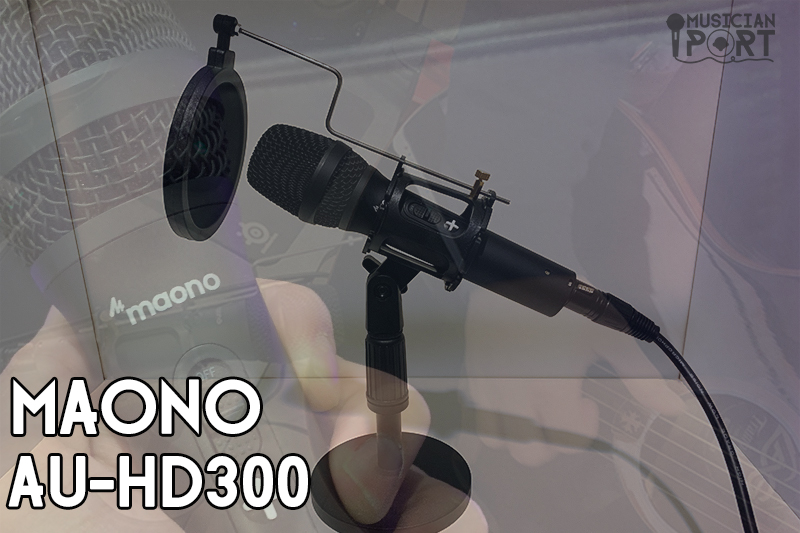Last updated on March 11th, 2021 at 03:35 am
To start off, I want to personally thank Maono for sending me their AU-HD300 Cardioid Dynamic USB/XLR Microphone before their release to try it out for myself. My first impression of the microphone is that I liked its portable design. The all-black style of this dynamic microphone is nice and looks good with my entire home recording studio set-up. It also feels durable and made with high-quality materials.
Table of Contents
The Specs
Maono sent me their “Desktop Stand Bundle” which comes with the AU-HD300 microphone, a desktop stand with an accompanying pop filter, USB-A to USB- C cable, and an XLR cable.
Dyanmic Microphone
The AU-HD300 is one of Maono’s newest dynamic microphones. These types of mics are often seen being used by singers and speakers on stage, however, it seems to me that Maono put this bundle for the target audience of people putting together a home studio. Just like most dynamic microphones, the AU-HD300 has a simple design, but still feels durable at the same time. In my hand, it feels light with more of the weight towards the center of the body.
Dynamic mics are known to be great for recording louder noises thanks to their capabilities of withstanding higher sound pressure levels. While this can be great for recording or capturing sounds in a louder environment, this might not be ideal if you’re trying to capture vocals in a studio. They aren’t the best for capturing the intricacies of sounds, something you need to consider especially if you plan to record high-quality vocals for songs.
Cardioid Polar Pattern
This microphone features a Cardioid Polar pattern, meaning that it has a high sensitivity to sound coming in from directly in front of it. They also pick up sound from the side of the microphones, but to a lesser extent. Cardioid mics do an excellent job at keeping out background noise from your recordings. You will find these microphones are great for recording an individual person or instrument.
The frequency response of this microphone is between 40Hz-17kHz with a sample rate of 44.1/48kHz; 16 bit.
Slick Design
Like we mentioned earlier, this microphone has a nice slick all-black design that compliments anyone’s recording set-up. It’s got a nice base to keep it stable on your desk while recording and a small pop filter that helps deal with plosives.
The shock mount helps suspend the microphone while it’s connected to the stand, helping reduce unwanted noises from being captured. It’s also designed to have the power switch and volume control buttons easily accessible for users.
I definitely think Maono did an excellent job with the overall design of this microphone and its desktop set-up.
Very convenient
One of my favorite parts about using this microphone is the ease of set-up. All I have to do is bring it out, connect it to my audio interface, and I’m good to go. It doesn’t take much space on my desk, and it’s super easy to move around. I sometimes find myself wanting to use this microphone more in situations where I only need to record a couple of takes of audio.
You have two options when it comes to connecting this microphone to your computer. First, we have the most convenient method, using the USB-C cable to connect directly to your computer’s USB input.
The second option is to connect the microphone with an XLR cable and audio interface. If you don’t already own an audio interface, check out our budget audio interface guide for more information. If you want the best sound quality from the AU-HD300 microphone, I highly recommend utilizing the XLR cable over the USB connection. Now, if you’re on a tighter budget, the USB-Type C connections will work fine and allow you to record straight to your computer.
An example of this is when I record voiceovers for videos that I make. I don’t have to go through the hassle of setting up my audio interface. All I have to do is grab my USB cable and record without having to leave the comfort of my chair.
Sound Quality is Surprisingly Good
I found that the sound quality was surprisingly good especially for a dynamic microphone at this price range. The timing of having this microphone was perfect too as I had just recently started dabbling in the streaming space on Twitch, YouTube, and Facebook. After a couple of sessions utilizing the mic for a variety of situations (voiceovers, singing/music recordings, and talking to people online, I found the Au-HD300 sufficient in getting the job done.
It’s not as sensitive as my condenser microphones, however, with the right amount of gain, the audio is crisp and great to work with. During a couple of online streams, I used this microphone to perform vocals or instruments with confidence that the sound wouldn’t clip.
I especially enjoyed using this microphone when performing on stream, giving the similar feel of performing on stage with a dynamic mic.
The Best Uses for this Microphone
Music Instruments and Performances
The AU-HD300 microphone is great for recording musical instruments. I have personally done some recording with my acoustic guitars and ukuleles. It did an excellent job at capturing the music I was playing while at the same time keeping background noise to a minimum.
Unlike my condenser microphones, I don’t have to worry too much about subtle unwanted sounds being picked up by the AU-HD300. After mixing down my recordings I am left with high-quality sound that was all captured by this microphone.
Voice Overs
I loved using this microphone when recording voiceovers. It’s convenient to use since Maono designed this package/set-up to easily fit on your desk. As a content creator who does voiceovers of a variety of different characters, the ease of use and quality of the audio made me excited to record on the spot. It’s easy to set up the microphone and start recording.
Recording Vocals/Streaming
Like we mentioned earlier, recording vocals are great with this microphone. I find myself worrying less about my audio clipping while recording, giving me the opportunity to experiment with a wide range of vocals. When it comes to streaming, whether it was on Twitch or YouTube, I did enjoy using the AU-HD300, however, I wouldn’t have it replace my condenser microphone set-up.
While it won’t be my primary mic for streaming any time soon, I do find it useful for the times I do “streaming concerts” for my audience. I can play my instruments and sing more freely, worrying less about my sound distorting and clipping. I also like grasping it in my hands while performing on stream, something you normally wouldn’t do with a condenser mic.
The Cons of this Microphone
The Pop Filter
Don’t get me wrong, the pop filter included did its job well when it comes to handling plosives. What I didn’t like about it is how it is set up with the overall stand. In my experience I found it a bit shaking and loose, finding myself constantly readjusting it whenever I moved it around.
Of course with the proper adjustments, you can get the pop filter at an alright distance from the microphone, but in my opinion, you’re better off buying a separate pop filter to use with this mic if you run into the same issues I was running into. Do keep in mind, you absolutely need to use a pop filter with this microphone as the plosives will sound harsh in your recordings without one.
Audio Recording Tests
Keep in mind that each audio recording is raw with nothing done in post. The only difference between each take is the amount of gain I used for the recording. Each testing section has audio recorded with gain at 50%, 75%, and 100%. I used the Focusrite Scarlett Solo audio interface instead of the USB-Type C connections to record these results.
The Results:
What I found was that a good sweet spot when it comes to the gain of this microphone is around 75%to 90%. At 50% gain, the recording was very soft. While you can bring the volume up in post, it might be easier to just record at a higher gain level in the first place. At 100% gain, the recordings come out too loud. You can also hear more background noise coming from external factors such as your computer, the fan, and other things in your room/studio.
At 75% gain, I found that the audio quality was loud enough to work with, but at the same time not capturing any unwanted external background noise. Do keep in mind that results may vary from set-up to set-up, so prepare to adjust settings accordingly to your needs.
Now let’s take a look at the results.
Voice Over Testing
I started off the testing of this microphone with some voiceovers.
Voice Over with 50% Gain
Voice Over with 75% Gain
Voice Over with 100% Gain
Vocals Testing (Singing)
Singing Test with 50% Gain
Singing Test with 75% Gain
Singing Test with 100% Gain
Guitar Testing
Guitar Test with 50% Gain
Guitar Test with 75% Gain
Guitar Test with 100% Gain
Final Thoughts
Overall, I’m highly impressed at how good of a job the AU-HD300 does as a “studio dynamic microphone.” Maono did an amazing job at having a high-quality mic at a nice affordable price tag. I definitely recommend this to anyone who plans to record musical instruments and even vocals inside the comfort of their own room/home studio.
While the USB connectivity is convenient, for the highest quality sound possible, always go with the XLR to audio interface connectivity. If you only plan to do some light recording like voiceovers for YouTube videos and other types of content, USB will be fine.
Check Price on Maono's Website






Leave a Comment